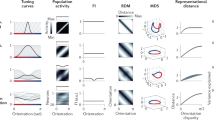Abstract
The function of CNS sites is frequently explored by an analysis of its input-output relationships. However, such research are often confined to a qualitative and subjective inspection of raw data. System Identification methods can be used to formalize the stimulus-response relations, and one of them, the Volterra approach, is employed here in order to define these relations in the MGB of the squirrel monkey, natural vocalizations being the stimuli. In order to validate the formal representation of the system under study, the predictibility power of the model is tested. Having the distances between responses (PSTH) and predicted response quantified, it is found that the predictions made by the model are, in general, “closer” to the actual responses then some arbitrarily chosen responses. It is concluded that there are cells in the MGB that can be characterized by their Volterra kernels, and further research on the cell's functional role can be based on these kernels.
Similar content being viewed by others
References
Aertzen, A.M.H.J.: Spectro temporal characterization of auditory neurons. Ph.D. Thesis, University of Nijmegen (1981)
Allon, N., Wollberg, Z.: Responses of cells in the superior colliculus of the squirrel monkey to auditory stimuli. Brain Res. 159, 321–330 (1978)
Allon, N., Yeshurun, Y., Wollberg, Z.: Responses of single cells in the medial geniculate body of awake squirrel monkeys. Exp. Brain Res. 41, 222–232 (1981)
Allon, N., Yeshurun, Y., Wollberg, Z.: Functional organization of the medial geniculate body's subdivisions of the awake squirrel monkey (in preparation)
Amorocho, J., Brandsteter, A.: Determination of nonlinear functional response functions in rainfall runoff processes. Water Resour. Res. 7, 1087–1101 (1971)
Capranica, R.R.: Why auditory neurophysiologists should be more interested in animal sound communication. The Physiologist 15 55–60 (1972)
Creutzfeldt, O., Hellweg, F.C., Schriener, C.: Thalamocortical transformation of responses to complex auditory stimuli. Exp. Brain Res. 39, 87–104 (1980)
Eggermont, J.J., Aertzen, A.M.H.J., Johannesma P.I.M.: Prediction of the responses of auditory neurons in the midbrain of the grass frog based on the spectro-temporal receptive field. Hearing Res. 10, 191–202 (1983)
Evans, E.F.: Peripheral processing of complex sounds. In: Bullock, T.H. ed. Dahlem workshop on recognition of complex acoustic signals (1977)
Fano, R.M.: Short time autocorrelation functions and power spectra. J. Acoust. Soc. Am. 22, 546–550 (1950)
Glass, I., Wollberg, Z.: Lability in the responses of cells in the auditory cortex of squirrel monkeys to species specific vocalizations. Exp. Brain Res. 34, 489–498 (1979)
Glass, I., Wollberg, Z.: Responses of cells in the auditory cortex of awake squirrel monkeys to normal and reversed vocalizations. Hearing Res. 9, 27–33 (1983a)
Glass, I., Wollberg, Z.: Anditory cortex responses to sequences of normal and reversed squirrel monkey vocalizations. Brain. Behav. Evol. 22, 13–21 (1983b)
Hung, G., Stark, L.: The kernel identification method (1910–1977)-review of theory, calculation, application, and interpretation. Math. Biosci. 37, 135–190 (1977)
Marmarelis, P.Z., Marmarelis, V.Z.: Analysis of physiological systems—the white noise approach. New York, London: Plenum Press 1978
Marmarelis, P.Z., Naka, K.I.: White noise analysis of a neuron chain: an application of the Wiener theory. Science 175, 1276–1278 (1972)
Marmarelis, P.Z., Naka, K.I.: Non linear analysis and synthesis of receptive field responses in the catfish retina. J. Neurophys. 36, 605–648 (1973)
Marmarelis, P.Z., Naka, K.I.: Identification of multiinput systems. IEEE Trans. Biomed. Eng. 21, 88–101 (1974)
Newman, J.D., Wollberg, Z.: Multiple coding of species specific vocalizations in the auditory cortex of squirrel monkey. Brain Res. 54, 287–304 (1973)
Volterra, V.: Theory of functionals. Glasgow: Blackie and Sons 1930
Wiener, N.: Nonlinear problems in random theory. New York: Wiley 1958
Winter, P., Ploog, D., Latta, Y.: Vocal repertoire of the squirrel monkey, its analysis and significance. Exp. Brain Res. 11, 359–384 (1966)
Author information
Authors and Affiliations
Additional information
Supported by a grant No. 84/B from “The Israel center for psychological biology”, Charles E. Smith foundation
Rights and permissions
About this article
Cite this article
Yeshurun, Y., Wollberg, Z., Dyn, N. et al. Identification of MGB cells by Volterra kernels. Biol. Cybern. 51, 383–390 (1985). https://doi.org/10.1007/BF00350778
Received:
Issue Date:
DOI: https://doi.org/10.1007/BF00350778




